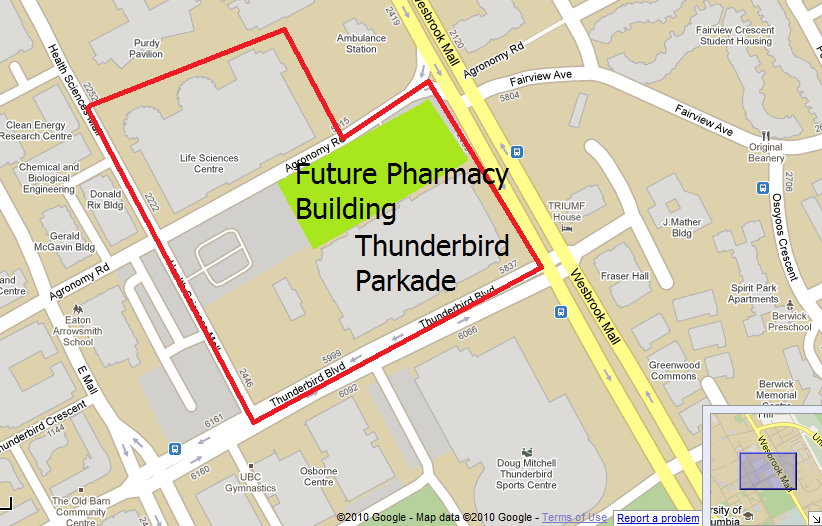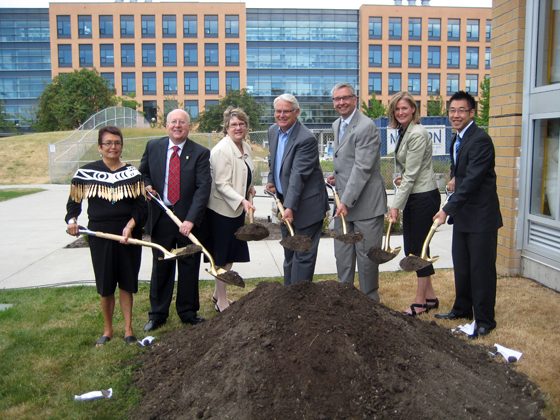Thunderbird Neighbourhood: The Impossible Density Transfer
Posted By Neal Yonson On October 12, 2010 @ 9:30 am In Featured,News | Comments Disabled
This post relates to the current Land Use Plan Revisions. While this post is hopefully clear enough on its own, you can read this post [1] for more background.
The Thunderbird neighbourhood was located between Thunderbird Boulevard and Agronomy Road, on the west side of Wesbrook mall. Because this area was designated as a neighbourhood when the old OCP was adopted, its destiny was supposed to be for use as private housing developments. As you can see however, in the intervening years, the Life Sciences Centre and a new parkade have been built on the site. Currently there is a large hole in the ground where construction of UBC’s new pharmacy building is taking place. Alas, no housing.
 [2]
[2]A rough outline of the location of the Thunderbird neighbourhood. The green square is currently a large hole where the new pharmacy building is being constructed.
Because the land is essentially all now being used for academic purposes (we won’t nitpick about the academic value of a parkade), one proposal in the LUP process is to redesignate the area as academic, and transfer the housing that was originally planned for the site to other areas of campus.
Here’s what the board document [3] says, verbatim: “The areas to be converted from ‘Future Housing’ to academic institutional lands include the UBC Farm, Totem Field, University Square, and the Thunderbird Neighbourhood. The housing density assigned to these areas must be transferred to other parts of campus to ensure that the community that develops on campus is ecologically, socially and financially sustainable.”
Unfortunately, there’s a slight problem with this proposal. Namely, it’s impossible: there is no housing density to be transferred.
The case of the missing housing density
When Part 10 of the Municipalities Enabling and Validating Act [4] (MEVA) was enacted earlier this year (aka Bill 20 [5]), giving UBC control over land use planning for the Vancouver campus, it specified a number of things about the LUP amendment process. In particular, it specifies that any changes to the LUP require community consultation. There must also be a public hearing before any changes can go to the minister. Ironically, MEVA also included this:
For the purposes of subsection (1), the UBC Area official community plan is modified in Schedule A by changing the designated use of the block of land immediately west of Wesbrook Mall and north of Thunderbird Boulevard from “Future Housing” to “UBC Core”.
The area described above is the Thunderbird neighbourhood. The designation for this area has already been changed to “UBC Core” in the legislation itself. The change took effect on June 24, 2010.
There was no community consultation, nor any public hearing about the change, the steps that are laid out as a minimum in the very same Act. All of the process requirements to make changes that are laid out in the rest of the Act were completely ignored. Thus, when UBC makes the claim that the housing density in that area must be transferred, they are being misleading at best, dishonest at worst. There is no density to be transferred because the designation was already changed away from “Future Housing” in a completely underhanded manner.
But why the rush? What was the imperative for making this change immediately in MEVA rather than waiting for the current process? In short, there was money on the table for a new pharmacy building and UBC had to rush the project ahead to take advantage of it.
As is typical in situations where something clearly shady went down, no one is taking responsibility for the change. UBC claims the designation change was the province’s idea because they have a very deep commitment to having an expanded pharmacy school at UBC. The Ministry of Community and Rural Development claims UBC is the one that pushed to include the change. Needless to say, it was obviously UBC’s idea but they apparently don’t want the credit.
Having Their Cake (and ice cream) and Eating it Too
Since the old OCP was enacted in 1997 which described the Thunderbird neighbourhood as “future housing”, UBC made the choice to build a parkade and the Life Sciences Centre there, and then to site the pharmacy building in the area. They knew the land was earmarked for residential development but made the conscious choice to use it for other purposes. Now that the land is not suitable for residential development because of the choices they made, they’re claiming that the housing capacity that was originally to be placed there must be found elsewhere. They’re trying to have their cake and eat it too.
To attempt a bad analogy, imagine you rent a 2-bedroom apartment. You use Bedroom #1 as a bedroom but decide to use Bedroom #2 as a home office. You then go to your landlord and ask for another bedroom somewhere in your building because Bedroom #2 is no longer suitable for use as a bedroom. After all, you were under the impression that you were getting a 2-bedroom apartment. Sounds insane, right? That’s essentially what UBC is doing here, except on a much larger scale.
They chose not to use the land for residential development and now they need to live with that choice. Rather than having the housing density transferred, it should eliminated. As pointed out ad nauseum, there’s nothing to transfer anyways.
Campus and Community Planning claims that when non-residential developments were being made on the site, it was always on the premise that the housing density would be moved elsewhere. That’s difficult to believe. Recent board documents about the Pharmacy building building from the April 8 [6] and June 9 [7] board meetings (both before MEVA was enacted) make no mention of the necessity of changing the designation, let alone the transfer of housing density. With the UBC Farm, the board made it crystal clear that the density assigned to the farm would have to be transferred. If that was the intention, they should have done the same in this case. It’s incredibly weak to claim, after the fact, that it was simply assumed density would be transferred. The concept that decisions have consequences apparently isn’t on the radar.
 [8]
[8]Groundbreaking for the new pharmacy building. Displacing dirt, as well as housing density. Photo (CC) BC Government.
Feeling good about the LUP consultation yet?
Let’s summarize here:
- In 1997, the OCP designates Thunderbird as “Future Housing.”
- Over the years, non-residential developments such as the Life Sciences Centre, Thunderbird Parkade and new Pharmacy building are built/planned. No residential developments are pursued for the site.
- In order to not lose funding for the construction of a new pharmacy building, the designation of the area of campus was changed without any sort of consultation or even an announcement.
- In the process, the housing density that was slated to be put there was lost.
- C&CP says the now non-existent housing density must be transferred to other areas of campus.
The story of the Thunderbird neighbourhood is another illustration of how the LUP consultation process is not being conducted in good faith. If it wasn’t clear enough already that the proposed changes will go through regardless of what people say, this makes it incontrovertible. In this case, they simply went ahead and made the changes they want without talking to anyone and are consulting after the fact. Pretending to be open to other opinions after doing so is the clumsiest and most dishonest form of lip service imaginable.
Article printed from UBC Insiders: http://ubcinsiders.ca
URL to article: http://ubcinsiders.ca/2010/10/thunderbird-neighbourhood-the-impossible-density-transfer/
URLs in this post:
[1] read this post: http://ubcinsiders.ca/2010/10/land-use-plan-revisions-a-massive-conflict-of-interest-from-here/
[2] Image: http://ubcinsiders.ca/wp/wp-content/uploads/2010/10/Thunderbird.png
[3] board document: http://www.planning.ubc.ca/database/rte/files/PB_RegularizeAcademicLandUse(2).pdf
[4] Municipalities Enabling and Validating Act: http://www.bclaws.ca/EPLibraries/bclaws_new/document/ID/freeside/00_01044_01#part10
[5] Bill 20: http://president.ubc.ca/2010/05/27/proposed-provincial-legislation-announced-bill-20/
[6] April 8: http://www.bog.ubc.ca/__shared/assets/SUB-10.04.08_7.1%20Pharmacy%20CDRD.pdf
[7] June 9: http://www.bog.ubc.ca/__shared/assets/SUB-BG-10-06-09_6.2%20Pharm%20CDRD.pdf
[8] Image: http://www.flickr.com/photos/bcgovphotos/4809754569/
Click here to print.